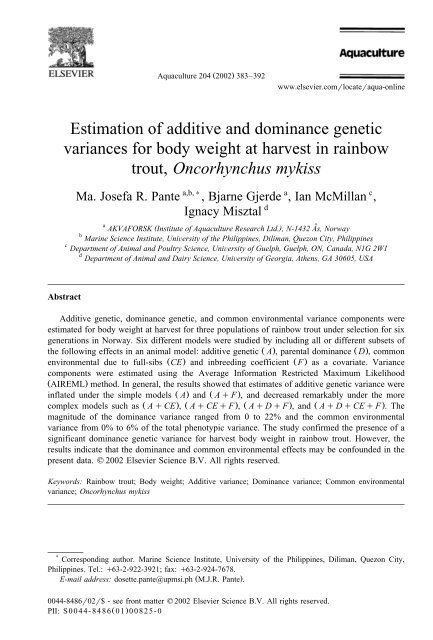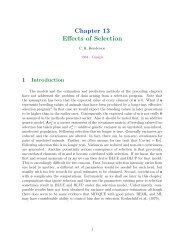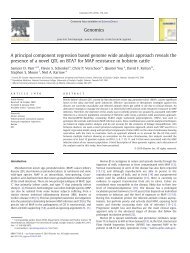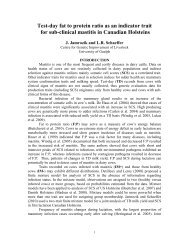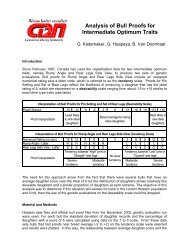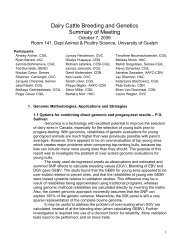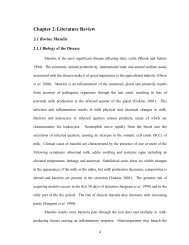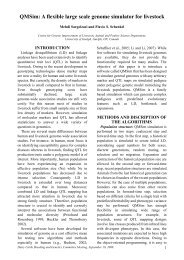Estimation of additive and dominance genetic variances for - CGIL ...
Estimation of additive and dominance genetic variances for - CGIL ...
Estimation of additive and dominance genetic variances for - CGIL ...
You also want an ePaper? Increase the reach of your titles
YUMPU automatically turns print PDFs into web optimized ePapers that Google loves.
Ž .<br />
Aquaculture 204 2002 383–392<br />
www.elsevier.comrlocateraqua-online<br />
<strong>Estimation</strong> <strong>of</strong> <strong>additive</strong> <strong>and</strong> <strong>dominance</strong> <strong>genetic</strong><br />
<strong>variances</strong> <strong>for</strong> body weight at harvest in rainbow<br />
trout, Oncorhynchus mykiss<br />
Ma. Josefa R. Pante a,b,) , Bjarne Gjerde a , Ian McMillan c ,<br />
Ignacy Misztal d<br />
a ˚<br />
AKVAFORSK ( Institute <strong>of</strong> Aquaculture Research Ltd. ) , N-1432 As, Norway<br />
b<br />
Marine Science Institute, UniÕersity <strong>of</strong> the Philippines, Diliman, Quezon City, Philippines<br />
c<br />
Department <strong>of</strong> Animal <strong>and</strong> Poultry Science, UniÕersity <strong>of</strong> Guelph, Guelph, ON, Canada, N1G 2W1<br />
d<br />
Department <strong>of</strong> Animal <strong>and</strong> Dairy Science, UniÕersity <strong>of</strong> Georgia, Athens, GA 30605, USA<br />
Abstract<br />
Additive <strong>genetic</strong>, <strong>dominance</strong> <strong>genetic</strong>, <strong>and</strong> common environmental variance components were<br />
estimated <strong>for</strong> body weight at harvest <strong>for</strong> three populations <strong>of</strong> rainbow trout under selection <strong>for</strong> six<br />
generations in Norway. Six different models were studied by including all or different subsets <strong>of</strong><br />
the following effects in an animal model: <strong>additive</strong> <strong>genetic</strong> Ž A . , parental <strong>dominance</strong> Ž D . , common<br />
environmental due to full-sibs Ž CE. <strong>and</strong> inbreeding coefficient Ž F. as a covariate. Variance<br />
components were estimated using the Average In<strong>for</strong>mation Restricted Maximum Likelihood<br />
Ž AIREML. method. In general, the results showed that estimates <strong>of</strong> <strong>additive</strong> <strong>genetic</strong> variance were<br />
inflated under the simple models Ž A. <strong>and</strong> Ž AqF . , <strong>and</strong> decreased remarkably under the more<br />
complex models such as Ž AqCE . , Ž AqCEqF . , Ž AqDqF . , <strong>and</strong> Ž AqDqCEqF . . The<br />
magnitude <strong>of</strong> the <strong>dominance</strong> variance ranged from 0 to 22% <strong>and</strong> the common environmental<br />
variance from 0% to 6% <strong>of</strong> the total phenotypic variance. The study confirmed the presence <strong>of</strong> a<br />
significant <strong>dominance</strong> <strong>genetic</strong> variance <strong>for</strong> harvest body weight in rainbow trout. However, the<br />
results indicate that the <strong>dominance</strong> <strong>and</strong> common environmental effects may be confounded in the<br />
present data. q 2002 Elsevier Science B.V. All rights reserved.<br />
Keywords: Rainbow trout; Body weight; Additive variance; Dominance variance; Common environmental<br />
variance; Oncorhynchus mykiss<br />
)<br />
Corresponding author. Marine Science Institute, University <strong>of</strong> the Philippines, Diliman, Quezon City,<br />
Philippines. Tel.: q63-2-922-3921; fax: q63-2-924-7678.<br />
E-mail address: dosette.pante@upmsi.ph Ž M.J.R. Pante . .<br />
0044-8486r02r$ - see front matter q 2002 Elsevier Science B.V. All rights reserved.<br />
Ž .<br />
PII: S0044-8486 01 00825-0
384<br />
1. Introduction<br />
( )<br />
M.J.R. Pante et al.rAquaculture 204 2002 383–392<br />
Breeding programs are designed to change the <strong>genetic</strong>s <strong>of</strong> a population to improve its<br />
productivity <strong>and</strong> pr<strong>of</strong>itability. In animal breeding, a considerable amount <strong>of</strong> <strong>genetic</strong><br />
progress has been achieved through the exploitation <strong>of</strong> the simple <strong>additive</strong> <strong>genetic</strong><br />
effects. Non-<strong>additive</strong> <strong>genetic</strong> components such as <strong>dominance</strong> <strong>and</strong> epistatic effects are<br />
usually ignored because they tend to be confounded with the common maternal<br />
environment; they have little practical application in selection Ž Mrode, 1996 . , <strong>and</strong> their<br />
estimation would involve large computational requirements Ž Varona <strong>and</strong> Misztal, 1999 . .<br />
However, accounting <strong>for</strong> non-<strong>additive</strong> <strong>genetic</strong> effects in <strong>genetic</strong> evaluation models is<br />
important <strong>for</strong> obtaining accurate predictions <strong>of</strong> breeding values <strong>of</strong> animals, to obtain a<br />
precise estimate <strong>of</strong> heritability <strong>and</strong> precise prediction <strong>of</strong> response to selection, <strong>and</strong> to<br />
help in deciding which breeding strategy <strong>and</strong> selection method should be utilized. There<br />
is a renewed interest in the estimation <strong>of</strong> non-<strong>additive</strong> <strong>genetic</strong> effects <strong>for</strong> important traits<br />
in domesticated animal species. This was set <strong>of</strong>f by the improvement in computing<br />
facilities <strong>and</strong> availability <strong>of</strong> s<strong>of</strong>tware ŽMeyer,<br />
1989; Hoeschele <strong>and</strong> Van Raden, 1991;<br />
Misztal, 1997. that permit estimation <strong>of</strong> non-<strong>additive</strong> <strong>genetic</strong> effects from large field<br />
data sets. Evidence <strong>of</strong> non-<strong>additive</strong> <strong>genetic</strong> variation <strong>for</strong> important traits has been<br />
reported in cattle ŽHoeschele,<br />
1991; Tempelman <strong>and</strong> Burnside, 1991; Fuerst <strong>and</strong><br />
Solkner, 1994; Miglior et al., 1995; Rodriguez-Almeida et al., 1995; Misztal, 1997;<br />
Misztal et al., 1997. <strong>and</strong> poultry ŽWei<br />
<strong>and</strong> van der Werf, 1993; Misztal <strong>and</strong> Besbes,<br />
2000 . .<br />
In fish, salmonids in particular, several studies suggest a significant <strong>and</strong> important<br />
influence <strong>of</strong> non-<strong>additive</strong> <strong>genetic</strong> effects on growth traits. In a majority <strong>of</strong> these studies,<br />
the presence <strong>of</strong> non-<strong>additive</strong> <strong>genetic</strong> effects was based on the observation <strong>of</strong> a larger<br />
dam than sire component <strong>of</strong> variance when estimated using a nested mating design<br />
Ž Gjedrem, 1983; Gall <strong>and</strong> Huang, 1988; Gjerde <strong>and</strong> Schaeffer, 1989. or by the presence<br />
<strong>of</strong> a significant sire by dam interaction Ž Gunnes <strong>and</strong> Gjedrem, 1981; McKay et al., 1986.<br />
when estimated using a factorial design. However, the dam component in the above<br />
studies may be inflated by effects common to full-sibs other than <strong>additive</strong> <strong>and</strong><br />
non-<strong>additive</strong> <strong>genetic</strong>s, i.e. common environmental <strong>and</strong> maternal effects. Gall Ž 1975.<br />
found evidence <strong>of</strong> non-<strong>additive</strong> <strong>genetic</strong> variation <strong>for</strong> post-spawning body weight among<br />
crosses <strong>and</strong> backcrosses in two strains <strong>of</strong> rainbow trout. In rainbow trout, evidence <strong>of</strong><br />
non-<strong>additive</strong> <strong>genetic</strong> effects is also seen by a significant inbreeding depression on<br />
growth Ž Pante et al., 2001a . , <strong>and</strong> significant heterosis when crossing inbred lines<br />
Ž Gjerde, 1988 . . However, low heterosis was found when crosses were per<strong>for</strong>med<br />
between wild strains <strong>of</strong> Atlantic salmon Ž Gjerde <strong>and</strong> Refstie, 1984 . .<br />
In studies that estimated the <strong>dominance</strong> <strong>genetic</strong> variance <strong>for</strong> important traits in fish,<br />
results indicate that its magnitude is within the range <strong>of</strong> the <strong>additive</strong> <strong>genetic</strong> variance.<br />
For example, in chinook salmon, the <strong>dominance</strong> variance <strong>for</strong> freshwater <strong>and</strong> saltwater<br />
weights were 0.26 <strong>and</strong> 0.08, respectively Ž Winkelman <strong>and</strong> Peterson, 1994a . . For body<br />
weight after 9 <strong>and</strong> 22 months <strong>of</strong> saltwater rearing, estimated <strong>dominance</strong> variance were<br />
0.19 <strong>and</strong> 0.27, respectively Ž Winkelman <strong>and</strong> Peterson, 1994b . . In Atlantic salmon, the<br />
<strong>dominance</strong> variance <strong>for</strong> body weight at harvest ranged from 0.02 to 0.18 depending on<br />
the models utilized Ž Rye <strong>and</strong> Mao, 1998 . . These estimates imply that <strong>dominance</strong> is an
( )<br />
M.J.R. Pante et al.rAquaculture 204 2002 383–392 385<br />
important source <strong>of</strong> <strong>genetic</strong> variation <strong>for</strong> some growth traits in fish. There<strong>for</strong>e, the<br />
purpose <strong>of</strong> this study was to determine the magnitude <strong>of</strong> <strong>additive</strong> <strong>and</strong> <strong>dominance</strong> <strong>genetic</strong><br />
<strong>variances</strong> <strong>for</strong> body weight at harvest <strong>of</strong> rainbow trout <strong>and</strong> the common environmental<br />
effect due to full-sib groups.<br />
2. Materials <strong>and</strong> methods<br />
Data were from three rainbow trout populations under selection <strong>for</strong> six generations<br />
at the Aqua Gen AS in Norway from 1972 to 1992. Each population was established<br />
separately in a different year Ž Table 1 . . The founding individuals <strong>for</strong> each population<br />
were from different fish farms in Norway <strong>and</strong> Sweden <strong>and</strong> thus were assumed to be<br />
from different gene pools. The pedigree data comprised seven generations Žgenerations<br />
0–6 . . Individual growth was measured as body weight Ž kg. at harvest recorded after<br />
16–18 months <strong>of</strong> rearing in floating net cages in the sea.<br />
The data analyzed were from generations 2–6 <strong>for</strong> all three populations <strong>and</strong> comprise<br />
a total <strong>of</strong> 15 year-classes Ž Table 1. <strong>and</strong> with a data structure as presented in Table 2. The<br />
fish were <strong>of</strong>fspring <strong>of</strong> broodstock selected mainly <strong>for</strong> fast growth rate, <strong>and</strong> the selection<br />
method practiced was a combination <strong>of</strong> between-family <strong>and</strong> within-family selection. A<br />
hierarchical mating design was applied where each sire is mated on average to two to<br />
three dams. In all generations, full- <strong>and</strong> half-sib matings were avoided <strong>and</strong> matings that<br />
would yield inbreeding coefficients <strong>of</strong> 12.5% or higher were restricted. Marking <strong>of</strong><br />
newly hatched larvae or fry is impossible; thus, each full-sib family was reared in<br />
separate tanks until reaching the average tagging size <strong>of</strong> 20 g. This introduces an<br />
environmental effect common to full-sib groups. To identify the families, a combination<br />
<strong>of</strong> fin clipping <strong>and</strong> freeze-br<strong>and</strong>ing was used Ž Gunnes <strong>and</strong> Refstie, 1980 . . The individuals<br />
selected as parents <strong>for</strong> the next generation were individually marked with operculum<br />
tags.<br />
Variance components <strong>for</strong> body weight at harvest were estimated <strong>for</strong> different effects<br />
fitted to a single trait animal model using the AIREMLF90 program ŽTsuruta<br />
<strong>and</strong><br />
Misztal, 2000 . . The algorithm uses the Average In<strong>for</strong>mation Ž AI. as second differentials<br />
Table 1<br />
The three separate populations analyzed in the study <strong>and</strong> the year-classes representing the time <strong>of</strong> hatching in<br />
each population<br />
Generation Population 1 Population 2 Population 3<br />
0 1972 1973 1974<br />
a 1 1975 1976 1977<br />
2 1978 1979 1980<br />
3 1981 1982 1983<br />
4 1984 1985 1986<br />
5 1987 1988 1989<br />
6 1990 1991 1992<br />
a The first generation where <strong>of</strong>fspring were selected <strong>for</strong> fast growth rate.
386<br />
( )<br />
M.J.R. Pante et al.rAquaculture 204 2002 383–392<br />
Table 2<br />
Number <strong>of</strong> sires, dams, <strong>of</strong>fspring <strong>and</strong> average body weight Ž kg. <strong>for</strong> the three populations <strong>of</strong> rainbow trout<br />
Population Number Number Number <strong>of</strong> Average body s.d. Ž kg.<br />
<strong>of</strong> sires <strong>of</strong> dams <strong>of</strong>fspring weight Ž kg.<br />
1 154 512 69,920 3.71 1.18<br />
2 165 456 62,897 3.70 1.27<br />
3 278 682 67,280 4.16 1.55<br />
<strong>of</strong> the likelihood function Ž Jensen et al., 1996 . . Six different models were studied by<br />
including all or different subsets <strong>of</strong> the following effects in the animal model: the<br />
r<strong>and</strong>om <strong>additive</strong> <strong>genetic</strong> effect, the r<strong>and</strong>om parental <strong>dominance</strong> <strong>genetic</strong> effect, the<br />
r<strong>and</strong>om common environmental effect due to full-sibs, <strong>and</strong> the inbreeding coefficient as<br />
a covariate:<br />
ysXhqZ 1aqe<br />
Ž 1.<br />
ysXhqbFqZ 1aqe<br />
Ž 2.<br />
ysXhqZ 1aqZ2cqe Ž 3.<br />
ysXhqbFqZ 1aqZ2cqe Ž 4.<br />
ysXhqbFqZ 1aqZ3dqe Ž 5.<br />
ysXhqbFqZ 1aqZ2cqZ3dqe Ž 6.<br />
where y is a vector <strong>of</strong> observations <strong>of</strong> animals; h is a vector <strong>of</strong> the fixed effects <strong>of</strong><br />
generation)location)cage)sex; a, d, c are r<strong>and</strong>om effects <strong>of</strong> direct <strong>additive</strong> <strong>genetic</strong>,<br />
parental <strong>dominance</strong> interaction, <strong>and</strong> common environment due to full-sib groups,<br />
respectively; b is the linear regression <strong>of</strong> y on inbreeding coefficients; F is the<br />
coefficient <strong>of</strong> inbreeding; X, Z 1, Z 2, Z3 are the corresponding incidence matrices<br />
relating the effects to y; <strong>and</strong> e is the vector <strong>of</strong> r<strong>and</strong>om residuals.<br />
Eq. Ž. 1 is the simple <strong>additive</strong> <strong>genetic</strong> model Ž A . ; Eq. Ž. 2 is the Ž AqF . model with<br />
<strong>additive</strong> <strong>genetic</strong> effects <strong>and</strong> the inbreeding coefficients as a linear covariate; Eq. Ž. 3 is<br />
model Ž AqCE. with the <strong>additive</strong> <strong>genetic</strong> <strong>and</strong> common environment effects; Eq. Ž 4. is<br />
model Ž AqCEqF . with the <strong>additive</strong> <strong>genetic</strong> <strong>and</strong> common environment effects <strong>and</strong><br />
with inbreeding coefficients as linear covariate; Eq. Ž. 5 is model Ž AqDqF . with<br />
<strong>additive</strong> <strong>and</strong> <strong>dominance</strong> <strong>genetic</strong> effects <strong>and</strong> inbreeding coefficients as covariate; <strong>and</strong> Eq.<br />
Ž. 6 is the full model Ž AqDqCEqF . , where all effects are fitted into the model. A<br />
model where only the <strong>additive</strong> <strong>and</strong> <strong>dominance</strong> <strong>genetic</strong> effects Ž AqD . are present was<br />
not included in the study because the inbreeding coefficient has to be fitted to obtain<br />
proper estimates <strong>of</strong> the <strong>dominance</strong> <strong>genetic</strong> effects Ž Hoeschele <strong>and</strong> Van Raden, 1991 . .<br />
The assumptions <strong>for</strong> the parameter means <strong>and</strong> <strong>variances</strong> were:<br />
2<br />
y X b<br />
A sa 0 0 0<br />
a<br />
0<br />
2<br />
a<br />
d<br />
0 0.25Dsd 0 0<br />
d 0<br />
2<br />
c 0 0 Isc 0<br />
E s ;Var s ,<br />
c<br />
e<br />
0<br />
0<br />
e<br />
0 0 0 2 Ise
( )<br />
M.J.R. Pante et al.rAquaculture 204 2002 383–392 387<br />
where s 2 is the <strong>additive</strong> <strong>genetic</strong> variance, s 2 is the <strong>dominance</strong> <strong>genetic</strong> variance, s 2<br />
a d c<br />
is the common environment variance, s 2 is the error variance, A is the <strong>additive</strong> <strong>genetic</strong><br />
e<br />
relationship matrix, D is the <strong>dominance</strong> <strong>genetic</strong> relationship matrix <strong>and</strong> I is an identity<br />
matrix. Note that parental <strong>dominance</strong> variance is one-quarter <strong>of</strong> the <strong>of</strong>fspring <strong>dominance</strong><br />
variance.<br />
Following the algorithm <strong>of</strong> Hoeschele <strong>and</strong> Van Raden Ž 1991 . , inbreeding was<br />
accounted <strong>for</strong> when inverting the A matrix but was ignored when inverting the D matrix.<br />
However, with low levels <strong>of</strong> inbreeding, including the individual inbreeding coefficients<br />
as a covariate in the model may be sufficient to account <strong>for</strong> ignoring inbreeding in<br />
<strong>for</strong>ming the inverse <strong>of</strong> the D relationship matrix Ž Hoeschele <strong>and</strong> Van Raden, 1991 . .<br />
Moreover, the covariance between the <strong>additive</strong> <strong>and</strong> <strong>dominance</strong> <strong>genetic</strong> effects was also<br />
ignored due to the large size <strong>of</strong> the data set.<br />
The estimated variance components were expressed as ratios <strong>of</strong> the total phenotypic<br />
Ž 2 . 2 2 2<br />
variance s <strong>for</strong> each model: the <strong>additive</strong> <strong>genetic</strong> variance ratio as h ss rs , i.e.<br />
t a t<br />
the heritability; the <strong>dominance</strong> <strong>genetic</strong> variance ratio as d 2 ss 2rs 2 d t ; <strong>and</strong> the common<br />
environmental variance ratio as c2 ss 2rs 2 c t .<br />
Log likelihood ratio tests were carried out among the six models to determine the<br />
most suitable <strong>of</strong> the six models. The likelihood ratio is LRsy2logwŽ rNz . rNz Ž .xs<br />
y2wlogŽ rNz . yŽlogŽ Nz .x, where logŽ Nz . is the maximum <strong>of</strong> the likelihood function <strong>for</strong><br />
the full model <strong>and</strong> logŽ rNz . is the maximum <strong>of</strong> the likelihood function <strong>for</strong> the reduced<br />
model subject to r number <strong>of</strong> constrained effects or parameters ŽLynch<br />
<strong>and</strong> Walsh,<br />
Table 3<br />
Ž 2 . Ž 2 . Ž 2 Estimates <strong>of</strong> <strong>additive</strong> h , <strong>dominance</strong> d , <strong>and</strong> common environmental c . <strong>variances</strong> expressed as ratio <strong>of</strong><br />
Ž . Ž 2 total phenotypic variance with their corresponding st<strong>and</strong>ard errors s.e. , <strong>and</strong> the residual variance s . e <strong>for</strong><br />
each <strong>of</strong> the model <strong>for</strong> the three populations <strong>of</strong> rainbow trout<br />
2 2 2 2<br />
Population Model h "s.e. d "s.e c "s.e. s e<br />
1 A 0.366"0.018 0.549<br />
Aq F 0.354"0.018 0.554<br />
AqCE 0.156"0.021 0.041"0.005 0.637<br />
AqCEq F 0.158"0.021 0.038"0.004 0.637<br />
Aq Dq F 0.162"0.023 0.144"0.005 0.635<br />
Aq DqCEq F 0.158"0.020 0.000"0.000 0.038"0.004 0.637<br />
2 A 0.365"0.019 0.559<br />
Aq F 0.344"0.018 0.570<br />
AqCE 0.087"0.018 0.062"0.006 0.681<br />
AqCEq F 0.089"0.017 0.055"0.005 0.681<br />
Aq Dq F 0.083"0.017 0.218"0.005 0.683<br />
Aq DqCEq F 0.082"0.017 0.161"0.013 0.014"0.013 0.684<br />
3 A 0.462"0.020 0.558<br />
Aq F 0.441"0.019 0.572<br />
AqCE 0.180"0.022 0.058"0.006 0.707<br />
AqCEq F 0.185"0.022 0.053"0.005 0.705<br />
Aq Dq F 0.167"0.022 0.216"0.005 0.713<br />
Aq DqCEq F 0.167"0.012 0.215"0.004 0.000"0.000 0.714
388<br />
( )<br />
M.J.R. Pante et al.rAquaculture 204 2002 383–392<br />
1997 . . An effect was considered to have a significant influence when its addition<br />
resulted to a significant increase in the log likelihood Ž y2logL . , compared to the model<br />
in which it was ignored. The LR test statistic is asymptotically distributed as x 2 , with r<br />
r<br />
degrees <strong>of</strong> freedom.<br />
3. Results<br />
Table 3 presents the estimates <strong>of</strong> variance components as proportions <strong>of</strong> the total<br />
phenotypic variance <strong>for</strong> the different models <strong>and</strong> <strong>for</strong> all three populations <strong>of</strong> rainbow<br />
trout. The results were fairly consistent across all three populations. In general, the<br />
heritability estimates from models Ž A. <strong>and</strong> Ž AqF . were inflated compared with<br />
estimates from the other models. Within a population, the heritability estimates were<br />
nearly similar <strong>for</strong> models such as Ž AqCE . , Ž AqCEqF . , Ž AqDqF . , <strong>and</strong> ŽAqD<br />
qCEqF . . With the simple <strong>additive</strong> <strong>genetic</strong> model Ž A . , the heritability ranged from<br />
0.365 to 0.462, which were similar to heritability values <strong>for</strong> growth-related traits in other<br />
salmonid species as estimated from sire components <strong>of</strong> variance Ž Gjedrem, 2000 . .<br />
When fitting the inbreeding coefficient as a covariate in the model Ž AqF . , the<br />
heritability decreased slightly by 0.01 to 0.02 when compared to model Ž A . . Also fitting<br />
Table 4<br />
Log likelihood values Ž y2logL. <strong>for</strong> the different models <strong>and</strong> the likelihood ratio Ž LR. when comparing each<br />
<strong>of</strong> the models with model Ž A.<br />
a<br />
Population Model y2logL LR<br />
1 A 689408.1<br />
Aq F 689393.1 y15.02 )<br />
AqCE 689357.2 y50.93 )<br />
AqCEq F 689347.2 y60.94 )<br />
Aq Dq F 689355.8 y52.33 )<br />
Aq DqCEq F 689347.2 y60.94<br />
2 A 622024.2<br />
Aq F 621998.5 y25.68 )<br />
AqCE 621953.9 y70.36 )<br />
AqCEq F 621926.0 y98.24 )<br />
Aq Dq F 621919.7 y104.50 )<br />
Aq DqCEq F 621919.1 y105.07<br />
3 A 672165.3<br />
Aq F 672132.5 y32.83 )<br />
AqCE 672063.2 y102.09 )<br />
AqCEq F 672039.7 y125.58 )<br />
Aq Dq F 672024.9 y140.43 )<br />
Aq DqCEq F 672024.9 y140.42<br />
a Ž .<br />
LR is the difference between the y2logL <strong>for</strong> the specified model <strong>and</strong> model A ; a negative value<br />
indicates improvement in the minimum <strong>of</strong> the likelihood.<br />
) Significant difference at P -0.01.<br />
)<br />
)<br />
)
( )<br />
M.J.R. Pante et al.rAquaculture 204 2002 383–392 389<br />
the common environmental Ž CE. effects Ž AqCE . , reduced the heritability by 0.21 to<br />
Ž 2 0.28 <strong>and</strong> estimates <strong>of</strong> the CE variance ratio c . ranged from 0.04 to 0.06. For model<br />
Ž . Ž . Ž 2 AqDqF the <strong>dominance</strong> D variance ratio d . ranged from 0.14 to 0.22, <strong>and</strong><br />
compared to model Ž AqCEqF . , the heritability slightly increased <strong>for</strong> population 1<br />
while a slight decrease was observed <strong>for</strong> populations 2 <strong>and</strong> 3. In all three populations,<br />
2 the estimate <strong>of</strong> d obtained from model Ž AqDqF . was close to four times the<br />
2 estimate <strong>for</strong> c obtained from model Ž AqCEqF . indicating that the estimates <strong>of</strong><br />
these two effects might be confounded.<br />
Ž . 2 2<br />
With the complete model AqDqCEqF , the estimates <strong>of</strong> d <strong>and</strong> c were<br />
reduced substantially compared to the estimates obtained from models Ž AqDqF . <strong>and</strong><br />
Ž . 2<br />
AqCEqF , respectively. However, in population 1, the d estimate was zero <strong>and</strong> the<br />
2 c estimate was identical to that obtained from the Ž AqCEqF . model, while in<br />
population 3, the c2 estimate was zero <strong>and</strong> the d 2 estimate was almost identical to that<br />
obtained from the Ž AqDqF . model, supporting that the estimated D <strong>and</strong> CE effects<br />
might be confounded. This is also supported by the magnitude <strong>of</strong> the residual variance,<br />
which in most cases, either increased marginally or remained the same when an effect<br />
was added to the model Ž Table 3 . .<br />
Table 4 presents the log likelihood values Ž y2logL. obtained <strong>for</strong> each model within a<br />
population <strong>and</strong> the values <strong>of</strong> the likelihood ratio Ž LR. test statistics. Fitting the<br />
inbreeding coefficient as a covariate or fitting, either the D or the CE effect always<br />
increased the log likelihood significantly. However the log likelihood was almost<br />
identical to that with the full model when the D effect was removed <strong>for</strong> population 1 or<br />
when the CE effect was removed <strong>for</strong> populations 2 <strong>and</strong> 3.<br />
4. Discussion<br />
The magnitude <strong>of</strong> the heritability estimate <strong>for</strong> body weight at harvest from models<br />
Ž A. <strong>and</strong> Ž AqF . were in agreement with previous heritability estimates <strong>for</strong> growth-related<br />
traits in salmonid species. In general <strong>for</strong> models Ž A. <strong>and</strong> Ž AqF . , <strong>and</strong> <strong>for</strong> models<br />
Ž AqCE. <strong>and</strong> Ž AqCEqF . , the inclusion <strong>of</strong> the inbreeding coefficients as a covariate<br />
did not seem to greatly influence the heritability estimate. This may be due to the<br />
relatively low average inbreeding in each population, which was estimated as less than<br />
9% Ž Pante et al., 2001b . .<br />
Fitting either the <strong>dominance</strong> <strong>genetic</strong> Ž D. or common environmental Ž CE. effects in<br />
the model resulted in a remarkable decrease in the heritability estimate while the<br />
residual variance either remained the same or increased slightly. This implies that a large<br />
proportion <strong>of</strong> the D <strong>and</strong> CE <strong>variances</strong> are included in the estimated <strong>additive</strong> <strong>genetic</strong><br />
variance when these effects are ignored in the model <strong>and</strong>, as expected, were not lost to<br />
the residual variance in the simple models. A substantial reduction in the <strong>additive</strong><br />
<strong>genetic</strong> variance <strong>for</strong> body weight at harvest when including the D <strong>genetic</strong> effect in the<br />
model was likewise observed in Atlantic salmon, whereas the presence <strong>of</strong> a CE effect<br />
only marginally influenced the <strong>additive</strong> <strong>genetic</strong> variance Ž Rye <strong>and</strong> Mao, 1998 . . In dairy<br />
cattle studies, only a small decrease in the <strong>additive</strong> <strong>genetic</strong> variance was observed when<br />
the D effect was included in the model Ž Miglior et al., 1995; Misztal et al., 1997 . , which
390<br />
( )<br />
M.J.R. Pante et al.rAquaculture 204 2002 383–392<br />
is most likely due to a smaller number <strong>of</strong> <strong>dominance</strong> relationships among the animals<br />
Ž Misztal et al., 1997 . . However, in fish populations, full-sib relationships dominate.<br />
Ž 2 The magnitude <strong>of</strong> the estimated D variance ratio d . is similar to, <strong>and</strong> in some cases<br />
much higher than, the heritability; ranging from 0% to 263% <strong>of</strong> the heritability estimate.<br />
The extreme value is very high compared to the range from 12% to 147% <strong>for</strong> body<br />
weight in Atlantic salmon Ž Rye <strong>and</strong> Mao, 1998 . , <strong>and</strong> 108% <strong>for</strong> body weight after 22<br />
months in saltwater <strong>for</strong> chinook salmon Ž Winkelman <strong>and</strong> Peterson, 1994b . . The results<br />
<strong>of</strong> this study along with the results from studies on other salmonid species indicate that<br />
D may be an important source <strong>of</strong> <strong>genetic</strong> variation <strong>for</strong> growth in these species.<br />
Ž 2 The estimated CE variance ratio c . ranging from 0 to 0.06 is in agreement with<br />
previous estimates <strong>for</strong> growth related traits in Atlantic salmon ŽRefstie<br />
<strong>and</strong> Steine, 1978;<br />
Gjerde et al., 1994; Rye <strong>and</strong> Mao, 1998. but the maximum value is less than the 0.08<br />
estimate <strong>for</strong> saltwater weight in chinook salmon Ž Winkelman <strong>and</strong> Peterson, 1994a. <strong>and</strong><br />
the 0.09 estimate <strong>for</strong> harvest body weight in rainbow trout ŽElvingson<br />
<strong>and</strong> Johansson,<br />
1993 . . Previous studies in salmonid species reported that the CE effects associated with<br />
full-sibs <strong>for</strong> traits close to time <strong>of</strong> harvesting diminish over time ŽGunnes<br />
<strong>and</strong> Gjedrem,<br />
1978; Elvingson <strong>and</strong> Johansson, 1993; Gjerde et al., 1994; Winkelman <strong>and</strong> Peterson,<br />
1994a . . However, the result from the present study suggests that the CE effect <strong>for</strong> body<br />
weight, though small in magnitude, is still significant at harvest time <strong>and</strong> has an<br />
influence on the estimate <strong>of</strong> the <strong>additive</strong> <strong>genetic</strong> variance. This result also calls attention<br />
to the importance <strong>of</strong> at least including the CE effect in models <strong>for</strong> estimating<br />
heritabilities <strong>and</strong> <strong>for</strong> predicting breeding values <strong>for</strong> growth-related traits in salmonids.<br />
In the present data, the CE <strong>and</strong> D effects appear to be confounded. Confounding <strong>of</strong><br />
CE <strong>and</strong> D, seems to be complete in population 1, but not in populations 2 or 3. For both<br />
effects, the design matrix is identical but the Ž co. variance structure differs. The average<br />
size <strong>of</strong> each full-sib group was about 100, <strong>and</strong> with such a large group size, the<br />
influence <strong>of</strong> the <strong>dominance</strong> relationship matrix on the prediction <strong>of</strong> <strong>dominance</strong> solutions<br />
appeared to be minimal. Similar confounding was observed <strong>for</strong> egg traits <strong>of</strong> laying hens<br />
Ž Misztal <strong>and</strong> Besbes, 2000 . . Separation <strong>of</strong> these two effects may require a different<br />
mating design to obtain stronger <strong>dominance</strong> <strong>genetic</strong> connections among the animals in<br />
the population. However, results obtained from Atlantic salmon with a similar data<br />
structure as in this study did not indicate strong confounding between common<br />
environmental <strong>and</strong> <strong>genetic</strong> effects Ž Rye <strong>and</strong> Mao, 1998 . .<br />
Because <strong>of</strong> confounding between the CE <strong>and</strong> D effects, a model <strong>for</strong> the prediction <strong>of</strong><br />
breeding values should include both <strong>of</strong> these effects. Both effects are important <strong>and</strong><br />
cannot be partitioned with sufficient accuracy. The complete model, Ž AqDqCEqF .<br />
is probably best <strong>for</strong> all future analyses <strong>of</strong> data sets involving a population structure more<br />
suited to estimating <strong>and</strong> predicting all the effects investigated here <strong>and</strong> with all effects<br />
being statistically significant.<br />
For future work, a simulation study is warranted to determine whether the confounding<br />
between the D <strong>and</strong> CE effects found in this study is due to methodological problems<br />
or the design <strong>of</strong> the specific breeding scheme. If a breeding scheme can be found that<br />
can provide simultaneously unbiased estimates <strong>of</strong> the D <strong>and</strong> CE effects, such a scheme<br />
should be applied to obtain more reliable estimates <strong>of</strong> variance components <strong>for</strong> these<br />
effects. Given a significant D <strong>genetic</strong> variance, studies should be undertaken to look
( )<br />
M.J.R. Pante et al.rAquaculture 204 2002 383–392 391<br />
into whether re-rankings <strong>of</strong> breeding values occur, particularly when the D effect is<br />
either ignored or included in <strong>genetic</strong> evaluation models <strong>and</strong> to look at mating <strong>and</strong><br />
breeding schemes that can exploit both the <strong>additive</strong> <strong>and</strong> <strong>dominance</strong> <strong>genetic</strong> effects in the<br />
breeding programs.<br />
Acknowledgements<br />
The authors would like to thank the Aqua Gen AS <strong>for</strong> providing the rainbow trout<br />
data <strong>and</strong> the Research Council <strong>of</strong> Norway <strong>for</strong> funding part <strong>of</strong> the study through Project<br />
No. 122859r122. The authors would also like to thank Dr. Larry Schaeffer <strong>for</strong> his<br />
invaluable comments to the manuscript. This work is part <strong>of</strong> the PhD studies <strong>of</strong> MJRP at<br />
the University <strong>of</strong> Guelph, Canada, that was funded by the International Development<br />
Research Centre Ž IDRC . .<br />
References<br />
Elvingson, P., Johansson, K., 1993. Genetic <strong>and</strong> environmental components <strong>of</strong> variation in body traits <strong>of</strong><br />
rainbow trout Ž Oncorhynchus mykiss. in relation to age. Aquaculture 118, 191–204.<br />
Fuerst, C., Solkner, J., 1994. Additive <strong>and</strong> non-<strong>additive</strong> <strong>genetic</strong> <strong>variances</strong> <strong>for</strong> milk yield, fertility, <strong>and</strong> lifetime<br />
per<strong>for</strong>mance traits <strong>of</strong> dairy cattle. J. Dairy Sci. 77, 1114–1125.<br />
Gall, G.A.E., 1975. Genetics <strong>of</strong> reproduction in domesticated rainbow trout. J. Anim. Sci. 40, 19–28.<br />
Gall, G.A.E., Huang, N., 1988. Heritability <strong>and</strong> selection schemes <strong>for</strong> rainbow trout: body weight. Aquaculture<br />
73, 43–56.<br />
Gjedrem, T., 1983. Genetic variation in quantitative traits <strong>and</strong> selective breeding in fish <strong>and</strong> shellfish.<br />
Aquaculture 33, 51–72.<br />
Gjedrem, T., 2000. Genetic improvement <strong>of</strong> cold-water fish species. Aquaculture Res. 31, 25–33.<br />
Gjerde, B., 1988. Complete diallele cross between six inbred groups <strong>of</strong> rainbow trout, Salmo gairdneri.<br />
Aquaculture 75, 71–87.<br />
Gjerde, B., Refstie, T., 1984. Complete diallel cross between five strains <strong>of</strong> Atlantic salmon. Livest. Prod. Sci.<br />
11, 207–226.<br />
Gjerde, B., Schaeffer, L.R., 1989. Body traits in rainbow trout: II. Estimates <strong>of</strong> heritabilities <strong>and</strong> <strong>of</strong> phenotypic<br />
<strong>and</strong> <strong>genetic</strong> correlations. Aquaculture 80, 25–44.<br />
Gjerde, B., Simianer, H., Refstie, T., 1994. Estimates <strong>of</strong> <strong>genetic</strong> <strong>and</strong> phenotypic parameters <strong>for</strong> body weight,<br />
growth rate <strong>and</strong> sexual maturity in Atlantic salmon. Livest. Prod. Sci. 38, 133–143.<br />
Gunnes, K., Gjedrem, T., 1978. Selection experiments with salmon: IV. Growth <strong>of</strong> Atlantic salmon during two<br />
years in the sea. Aquaculture 34, 327–332.<br />
Gunnes, K., Gjedrem, T., 1981. A <strong>genetic</strong> analysis <strong>of</strong> body weight <strong>and</strong> length in rainbow trout reared in<br />
seawater <strong>for</strong> 18 months. Aquaculture 24, 161–174.<br />
Gunnes, K., Refstie, T., 1980. Cold-br<strong>and</strong>ing <strong>and</strong> fin-clipping <strong>for</strong> marking salmonids. Aquaculture 19,<br />
295–299.<br />
Hoeschele, I., 1991. Additive <strong>and</strong> non-<strong>additive</strong> <strong>genetic</strong> variance in female fertility <strong>of</strong> Holsteins. J. Dairy Sci.<br />
74, 1743–1752.<br />
Hoeschele, I., Van Raden, P.M., 1991. Rapid inversion <strong>of</strong> <strong>dominance</strong> relationship matrices <strong>for</strong> non-inbred<br />
populations by including sire by dam subclass effects. J. Dairy Sci. 74, 557–569.<br />
Jensen, J., Mantysaari, E.A., Madsen, P., Thompson, R., 1996. Residual maximum likelihood estimation <strong>of</strong><br />
Ž co. variance components in multivariate mixed linear models using average in<strong>for</strong>mation. J. Indian Soc. Ag.<br />
Stat. 49, 215–236.<br />
Lynch, M., Walsh, B., 1997. Genetics <strong>and</strong> Analysis <strong>of</strong> Quantitative Traits. Sinauer Associates, Sunderl<strong>and</strong>,<br />
MA, USA.
392<br />
( )<br />
M.J.R. Pante et al.rAquaculture 204 2002 383–392<br />
McKay, L.R., Ihssen, P.E., Friars, G.W., 1986. Genetic parameters <strong>of</strong> growth in rainbow trout, Salmo<br />
gairdneri, as a function <strong>of</strong> age <strong>and</strong> maturity. Aquaculture 58, 241–254.<br />
Meyer, K., 1989. Restricted maximum likelihood to estimate variance components <strong>for</strong> animal models with<br />
several r<strong>and</strong>om effects using a derivative-free algorithm. Genet., Sel., Evol. 21, 317–340.<br />
Miglior, F.A., Burnside, E.B., Kennedy, B.W., 1995. Production traits in Holstein cattle: estimation <strong>of</strong><br />
non-<strong>additive</strong> <strong>genetic</strong> variance components <strong>and</strong> inbreeding depression. J. Dairy Sci. 78, 1174–1180.<br />
Misztal, I., 1997. <strong>Estimation</strong> <strong>of</strong> variance components with large-scale <strong>dominance</strong> models. J. Dairy Sci. 80,<br />
965–974.<br />
Misztal, I., Besbes, B., 2000. Estimates <strong>of</strong> parental-<strong>dominance</strong> <strong>and</strong> full-sib permanent environment <strong>variances</strong><br />
in laying hens. Anim. Sci. 71, 421–426.<br />
Misztal, I., Lawlor, T.J., Fern<strong>and</strong>o, R.L., 1997. Dominance models with method R <strong>for</strong> stature <strong>of</strong> Holsteins. J.<br />
Dairy Sci. 80, 975–978.<br />
Mrode, R.A., 1996. Linear Models <strong>for</strong> the Prediction <strong>of</strong> Animal Breeding Values. CAB International,<br />
Walling<strong>for</strong>d, Oxon, UK.<br />
Pante, M.J.R., Gjerde, B., McMillan, I., 2001a. Effect <strong>of</strong> inbreeding on body weight at harvest in rainbow<br />
trout, Oncorhyncus mykiss. Aquaculture 192, 201–211.<br />
Pante, M.J.R., Gjerde, B., McMillan, I., 2001b. Inbreeding levels in selected populations <strong>of</strong> rainbow trout,<br />
Oncorhynchus mykiss. Aquaculture 192, 213–224.<br />
Refstie, T., Steine, T., 1978. Selection experiment with salmon: III. Genetic <strong>and</strong> environmental sources <strong>of</strong><br />
variation in length <strong>and</strong> weight <strong>of</strong> Atlantic salmon in the freshwater phase. Aquaculture 14, 221–234.<br />
Rodriguez-Almeida, F.A., Van Vleck, L.D., Wilham, R.L., Northcutt, S.L., 1995. <strong>Estimation</strong> <strong>of</strong> non-<strong>additive</strong><br />
<strong>genetic</strong> <strong>variances</strong> in three synthetic lines <strong>of</strong> beef cattle using an animal model. J. Anim. Sci. 73,<br />
1002–1011.<br />
Rye, M., Mao, I.L., 1998. Non<strong>additive</strong> <strong>genetic</strong> effects <strong>and</strong> inbreeding depression <strong>for</strong> body weight at harvest in<br />
Atlantic salmon Ž Salmo salar L. . . Livest. Prod. Sci. 57, 15–22.<br />
Tempelman, R.J., Burnside, E.B., 1991. Additive <strong>and</strong> <strong>dominance</strong> <strong>genetic</strong> variation <strong>for</strong> dairy production traits<br />
under an animal model. J. Anim. Breed. Genet. 108, 330–342.<br />
Tsuruta, S., Misztal, I., 2000. AIREMLF90. Web site at http:rrnce.ads.uga.edur ;ignacy.<br />
Varona, L., Misztal, I., 1999. Prediction <strong>of</strong> parental <strong>dominance</strong> combinations <strong>for</strong> planned matings, methodology<br />
<strong>and</strong> simulation results. J. Dairy Sci. 82, 2186–2191.<br />
Wei, M., van der Werf, J.H.J., 1993. Animal model estimation <strong>of</strong> <strong>additive</strong> <strong>and</strong> <strong>dominance</strong> <strong>variances</strong> in egg<br />
production traits <strong>of</strong> poultry. J. Anim. Sci. 71, 57–65.<br />
Winkelman, A.M., Peterson, R.G., 1994a. Heritabilities, <strong>dominance</strong> variation, common environmental effects<br />
<strong>and</strong> genotype by environment interactions <strong>for</strong> weight <strong>and</strong> length in chinook salmon. Aquaculture 125,<br />
17–30.<br />
Winkelman, A.M., Peterson, R.G., 1994b. Genetic parameters Žheritabilities,<br />
<strong>dominance</strong> ratios, <strong>and</strong> <strong>genetic</strong><br />
correlations. <strong>for</strong> body weight <strong>and</strong> length <strong>of</strong> chinook salmon after 9 <strong>and</strong> 22 months <strong>of</strong> saltwater rearing.<br />
Aquaculture 125, 30–36.


